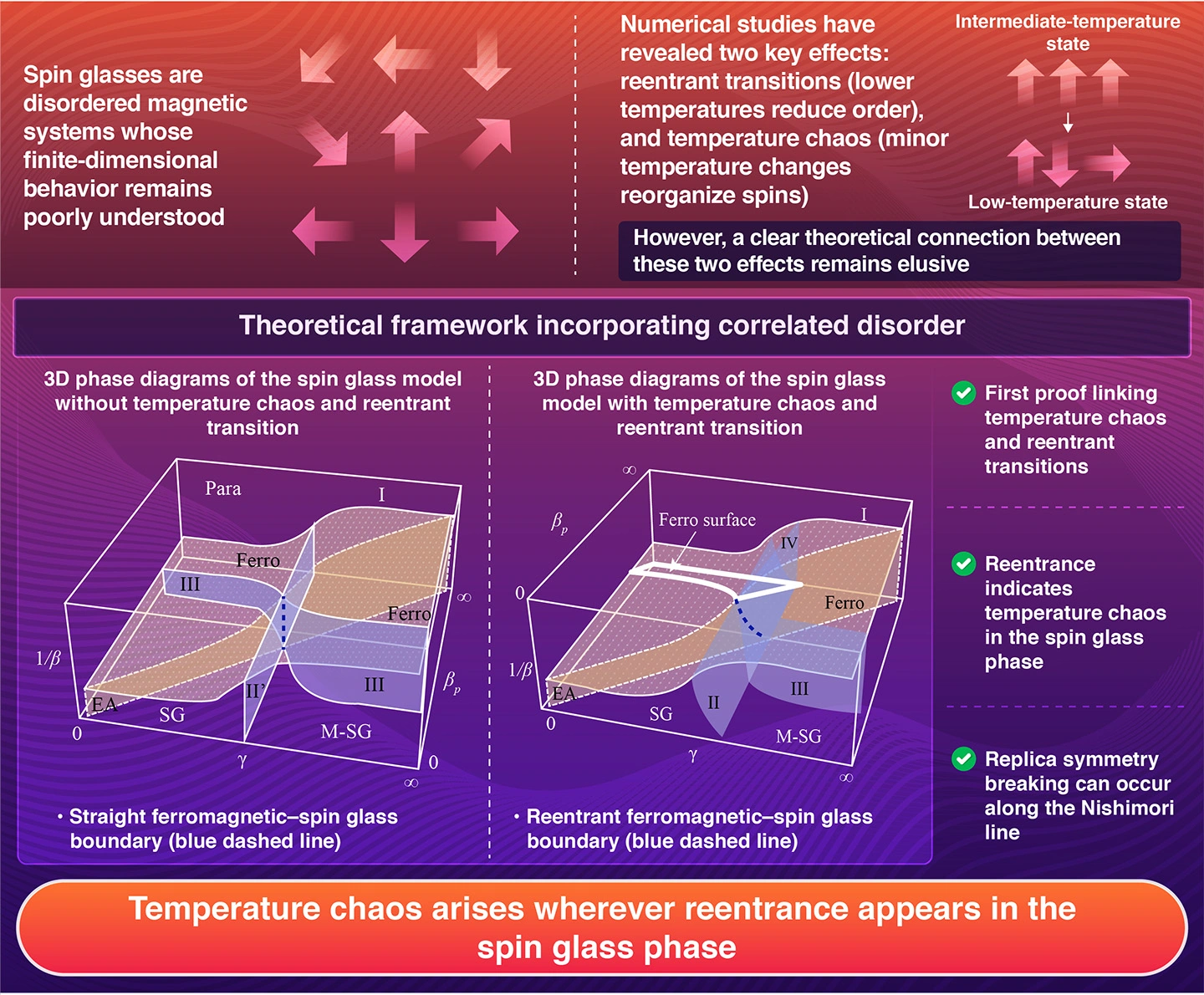A fundamental link between two counterintuitive phenomena in spin glasses- reentrance and temperature chaos-has been mathematically proven for the first time. By extending the Edwards-Anderson model to include correlated disorder, researchers at Science Tokyo and Tohoku University provided the first rigorous proof that reentrance implies temperature chaos. The breakthrough enhances understanding of disordered systems and could advance applications in machine learning and quantum technologies, where controlling disorder and errors is crucial.
Mathematical Link Between Reentrant Transitions and Temperature Chaos in Spin Glasses

Nishimori et al. (2025) | Physical Review E | 10.1103/qp1w-qcbs
Spin glasses are magnetic materials in which atomic "spins," or tiny magnetic moments, point in random directions rather than aligning neatly as in a regular magnet. These disordered spins can remain stable for extremely long periods of time, possibly even indefinitely. This frozen randomness gives rise to unusual physical properties not seen in any other physical system.
To describe the spin glass behavior, physicists use models such as the Edwards-Anderson (EA) model, which simulates how spins interact in two or three dimensions-conditions that more closely reflect real-world systems than the well-studied mean-field model. Numerical studies of the EA model have uncovered two strange and counterintuitive phenomena: reentrant transitions and temperature chaos.
In a reentrant transition, lowering the temperature makes the system less ordered, which is the opposite of what one would normally expect when cooling a material. This behavior has been observed near the boundary between ferromagnetic and spin glass or paramagnetic phases in multiple dimensions. Temperature chaos, on the other hand, describes a phenomenon in which even a tiny change in temperature completely reorganizes the material's internal spin structure.
Now a research team led by Specially-appointed Professor Hidetoshi Nishimori from Institute of Science Tokyo (Science Tokyo) has shown that these two phenomena are linked. The study which was published in the journal Physical Review E on October 22, 2025, presents the first mathematical proof that the existence of reentrance in the EA model implies the presence of temperature chaos.
The team reached this conclusion by extending existing theoretical frameworks and introducing correlations in the disorder variables, to control the level of frustration, which is a key feature of disordered systems. Their analysis revealed that when temperature chaos is absent, the boundary between ferromagnetic (ordered) and spin glass (disordered) states remains straight and non-reentrant. In other words, when the same boundary bends back on itself, meaning reentrance, temperature chaos exists.
"Our study establishes a highly nontrivial mathematical relationship between two seemingly unrelated physical phenomena observed in different regions of the phase diagram. It takes a significant step toward a more comprehensive understanding of the Edwards-Anderson model through exact analysis, uncovering an unexpected connection between temperature chaos and reentrance-phenomena that are seemingly unrelated from a physical standpoint," explains Nishimori.
The team also demonstrated that if replica symmetry breaking (a property that two copies of the same system behave differently) is assumed to occur in the EA model, then the distribution of magnetization exactly matches the distribution of replica overlap on the Nishimori line. This finding suggests that macroscopic quantities like magnetization can fluctuate between measurements, highlighting how deeply disorder and correlation affect the system's collective behavior. It also proves that replica symmetry breaking may exist on the Nishimori line, contrary to long-held belief. The absence of replica symmetry breaking on the Nishimori line has formed the one of the bases of Bayesian inference, which has important applications in machine learning.
By using a symmetry-based approach, the researchers were able to prove the connection with relatively simple mathematics. Their framework shows that the apparent unpredictability of spin glasses can emerge from gauge symmetries and disorder correlations.
"This work pioneers a new pathway toward clarifying how complex behaviors in disordered systems emerge. Understanding spin glasses goes beyond the study of magnets: The concepts of disorder, frustration, and complex energy landscapes play crucial roles in diverse areas such as materials science, Bayesian inference, optimization problems, and error correction in quantum computing," adds Nishimori.
The discovery not only advances the theoretical understanding of spin glasses but also holds potential applications in machine learning and quantum technologies where controlling errors and disorder is crucial.
Reference
- Authors:
- Hidetoshi Nishimori1,2,3*, Masayuki Ohzeki2,4,5, and Manaka Okuyama2,6
*Corresponding author
- Title:
- Temperature chaos as a logical consequence of the reentrant transition in spin glasses
- Journal:
- Physical Review E
- DOI:
- 10.1103/qp1w-qcbs
- Affiliations:
- 1 Institute of Integrated Research, Institute of Science Tokyo, Japan
2 Graduate School of Information Sciences, Tohoku University, Japan
3 RIKEN Interdisciplinary Theoretical and Mathematical Sciences (iTHEMS), RIKEN, Japan
4 Department of Physics, Institute of Science Tokyo, Japan
5 Sigma-i Co., Ltd., Japan
6 School of Computing, Institute of Science Tokyo, Japan






